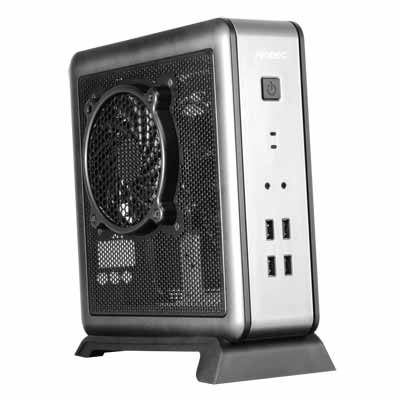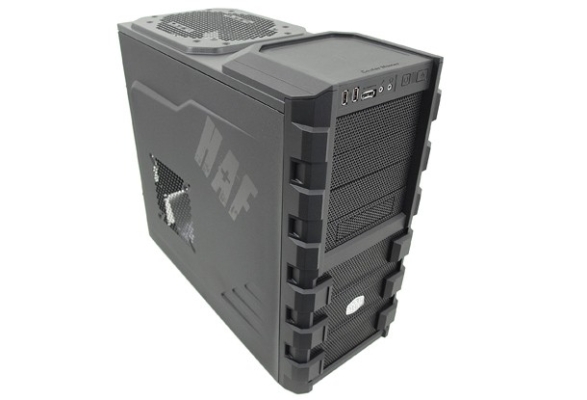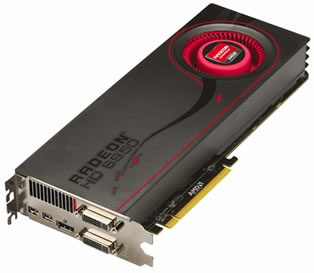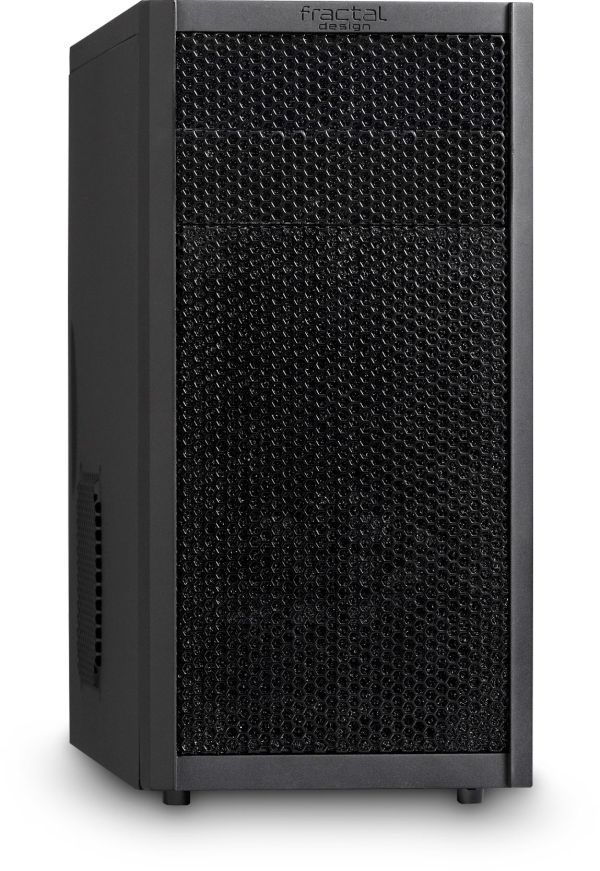Back To School Technology Buyer's Guide
by Zach Throckmorton on August 4, 2011 8:55 PM ESTBuild your own PC
You can usually build a desktop computer for less money than it costs to buy a comparably-specced system from a retailer. The discrepancy generally becomes greater as overall cost and capability go up. Additionally, many college students have access to very low cost Windows 7 licenses. For example, Windows 7 Ultimate costs students here at UW-Madison $64, while at Indiana University it's $20 and at the University of Michigan, $19 (Wolverines can also buy Vista for $9.50—curb your enthusiasm). Be sure to check with your specific college to see if you can get Windows (and other useful software) at a discount before paying retail prices for your OS. Because the cost of the OS varies dramatically from college to college, it is omitted from the following builds.
With that important consideration, let's get to the builds! We present here three configurations: a very tiny but capable mini-ITX system, a relatively small, inexpensive micro-ATX rig, and a more powerful mid-tower. We also suggest upgrades for each computer tailored to different uses.
Intel Mini-ITX System
| Intel Core i3 Sandy Bridge mini-ITX PC | |||||
| Component | Product Name | Cost | |||
| Case + PSU | Antec ISK 100 80W PSU | $85 | |||
| CPU | Intel Core i3-2100T | $135 | |||
| Motherboard | ASUS P8H61-I (Rev. 3.0) | $85 | |||
| Memory | Patriot 4GB (2x2GB) DDR3 SDRAM | $33 | |||
| Hard drive | Samsung Spinpoint MP4 HM320HJ 320GB | $48 | |||
| Total: | $386 | ||||

This mini-ITX system built in an Antec ISK 100 is more than powerful enough to handle web browsing, HD video playback, photo and video editing, many kinds of scientific analysis, and of course, office productivity. It's also sufficiently powerful that you should expect to be able to use it to perform these tasks for your entire four year undergraduate career. Best of all, its tiny case measures less than 9" tall by 9" deep by 4" wide. That's about the size of a hardcover novel (and smaller than an intro biology text!)—saving valuable real estate in a cramped dorm room, for example. Once assembled, it will weigh less than four pounds. It's important to note that the ultra low-profile heatsink that comes with the Core i3-2100T fits inside the ISK 100, but the stock heatsink that comes with the Core i3-2100 does not. Gelid makes a low-profile heatsink that would let you use a Core i3-2100 in the ISK 100 but it is difficult to find. Perhaps its only drawbacks given its size are that it lacks an optical drive and it is not a gaming computer, nor can it be upgraded to become a gaming computer. That said, there is room for two 2.5" hard drives, so you could certainly upgrade it for faster responsivity by adding an SSD or for more storage by adding a more spacious, slower 2.5" mechanical drive.
AMD Micro-ATX System
| AMD Athlon II X3 Micro-ATX PC | ||
| Component | Product Name | Cost |
| Case | Fractal Design Core 1000 | $50 |
| PSU | XIGMATEK ACXTNRP-PC402 400W | $35 |
| CPU | AMD Athlon II X3 445 | $75 |
| Motherboard | Biostar A880G+ | $55 |
| Memory | Patriot 4GB (2x2GB) DDR3 SDRAM | $33 |
| Hard drive | Western Digital WD5000AAKX 500GB | $40 |
| Optical drive | LITE-ON iHAS124-04 | $20 |
| Total: | $298 | |
While the AMD Athlon II X3 445 is slightly less powerful than the Intel Core i3-2100T in the mini-ITX system, it is nevertheless a potent processor up to most tasks, and certainly more than sufficient to provide four years of basic computing. This AMD CPU offers tremendous value—a lot of bang for the buck. Importantly, should you deem more power necessary in a few years, the six core Thuban CPUs will be simple, drop-in upgrades and by then, likely will cost less than $100. That said, the tri-core chip will remain a capable office system processor for four years. For an idea of how it performs, check AnandTech's Bench.
The Fractal Design Core 1000 is one of my favorite newer cases to hit the market. Its low price tag, quality construction, smaller size, and aesthetics are major selling points. At less than 17" deep by 7" wide by 14" tall, it's more compact than many micro-ATX cases, yet large enough to hold many hard drives, a bigger aftermarket CPU heatsink, and/or a larger GPU if you want to upgrade it. I find its thermals are slightly improved by moving the front intake fan to the rear of the case to act as an exhaust.
Biostar's A880G+ is a great value; it's a well-featured budget board that even has an HDMI port, and its integrated Radeon HD 4250 graphics are more than adequate for running Windows' Aero feature and Flash games. Perhaps its only drawback at this price point is its lack of USB 3.0 ports, which will become increasingly useful, though again at this low price, they aren't expected (and a USB 3.0 expansion bracket could be added later if the need arises). Finally, the Xigmatek PC402 400W PSU is relatively well-built for its price tag, and has a quiet 140mm fan.
This system could easily be turned into a respectable gaming rig by adding a discrete video card. Given the thermal limitations of the case at stock, I suggest adding a 120mm fan for better airflow. And given the limitations of the 400W PSU, I wouldn't add a GPU that's more power-hungry than a Radeon HD 6870, and even that would require a molex-PCIe adapter. The Radeon HD 6770 (the rebadged Radeon HD 5770) remains a very strong value for $100 or less after rebate, providing gamers acceptable frame rates or better at resolutions lower than 1080p with medium settings in all but the most demanding games.
Intel Mid-Tower System
| Intel Core i5 Sandy Bridge ATX PC | |||
| Component | Product Name | Cost | Rebate |
| Case | Cooler Master HAF 912 | $75 | -$10 |
| PSU | Antec Earthwatts 430W | $44 | |
| CPU | Intel Core i5-2500K | $220 | |
| CPU heatsink | Cooler Master Hyper 212+ | $30 | |
| Motherboard | Biostar TZ68A+ | $100 | |
| Memory | Patriot 8GB Gamer 2 Series (2x4GB) DDR3 SDRAM | $55 | -$20 |
| Primary storage | OCZ Vertex 2 solid state drive | $100 | |
| Secondary storage | Western Digital 1TB 5400RPM WD10EARS hard drive | $55 | |
| Video card | XFX HD-679X-ZDFC Radeon HD 6790 | $135 | -$15 |
| Optical drive | Samsung SH-222AB | $19 | |
| Total: | $833 | $788 | |

If you have more space than a typical dorm room (or think having a powerful computer is worth being even more cramped than usual in a dorm room), this midtower has all the bases covered. The Cooler Master HAF 912 features excellent thermals (HAF stands for high air flow), integrated mounts for 2.5" SSDs, solid cable management, and it's capacious enough for larger video cards and aftermarket CPU heatsinks. At 20" deep by just over 9" wide by 19" tall and weighing in at 18 pounds, it's probably not going to disappear if you inadvertently leave your room unlocked.
The Intel Core i5-2500K is an extremely potent CPU that will remain a very solid processor for four more years (think of how 2007's Q6600 is still a capable chip). Its performance metrics are available in Bench. The Cooler Master Hyper 212+ is a great value, and should allow you to overclock the CPU to 4GHz with minimal effort, though better chips can hit 4.5GHz and some even approach 5GHz. I've had excellent results from the Biostar motherboard in terms of overclocking, and its low price for a Z68-chipset board with all the bells and whistles makes it a compelling option. Of course, a system like this should have an SSD for overall responsiveness, and the OCZ Vertex 2 is a venerable stalwart at an increasingly low price. The 1TB low RPM hard drive offers plenty of storage, though you could certainly swap it out for a larger, faster (i.e. 7200RPM) hard drive if you'll be installing a lot of games that won't fit on the SSD and will benefit from not being put on a 'green' drive.

Finally, we've opted to recommend a Radeon HD 6790 because of its value, though a GeForce GTX 460 1GB might be worth spending a few dollars more for a bit better performance. If you want to spring for GPUs that will play the latest titles for a year or two longer than these, consider the AMD Radeon HD 6950 and NVIDIA GeForce GTX 560 Ti. These cards trade blows both in terms of performance and are priced at $200 or slightly higher.
While these do it yourself builds cover a range of typical college uses and needs, we recognize that many readers prefer retail, pre-built systems. Therefore a few models are discussed on the next page.











94 Comments
View All Comments
The0ne - Friday, August 5, 2011 - link
I think the recommendations covers too broad the general view of a college student. Many of these aren't even needed as a good 15" or even a 17" will do just fine. If you want to game, that's a whole different area to pursue with even more accessories to consider. It's not as if you are going to lug around all those equipments with you on campus nor have all the time in the world to do everything.I also vote for the inclusion of a very good bag to lug around books and your accessories!
Fujikoma - Friday, August 5, 2011 - link
Given how most students live, I'd recommend a desktop for durability. Most really don't need the extra power and could get by with a laptop, but most aren't careful enough when it comes to long term care. There were three of us in a 12'X12' room (largest on campus) and we shared one desktop (early 90's and two of us couldn't afford one) instead of going to the eng. bldg. With the exception of the music student (Apple fanatic), everyone owned an intel/amd custom build with one atari (800XL) and one commodore (don't remember) thrown in for good measure. Maybe it was because we were all science/eng. majors. The laptop, a friend lent me, didn't help during class. It was much easier taking notes. Of course, playing games during a boring lecture was a bonus, but the laptop really had no value. A laptop really serves a student that goes home regularly and needs to work on their classwork while away. Of course, I don't think graphing calculators should be allowed in any math class prior to differential equations. Same thing with the iPads the local middle school is buying instead of books... it has no place in a school. Call me old fashioned but learning how to solve a problem the hard way with repetition is far better than just entering data and letting a gadget do all the work (our interns (and a few of our engineers) are idiots who have very little comprehension of why things don't work).I have a 17" screen on my laptop, because it's as small as I'll go when I visit family out of state and I need to work on graphics stuff. Otherwise, it's my excessively large tower (very old, but easy to keep cool) with a much better and larger monitor.
andymcca - Friday, August 5, 2011 - link
I just bought a Llano machine for $400 after a $50 rebate. It's an HP G6-1b60us, and while historically I've not been an HP fan, I'm impressed. Granted, its based on an A4-3300M (lower end Llano), but the few games I've tried so far (WoW, Starcraft 2) play great with a mix of "ultra" and medium settings. It might be worth mentioning that there are some Llano machines well under $700.I am annoyed at certain retailer, though. We will call it "small center". The sales person was trying to tell me that it might not even launch old games or something. I tried to let him know that integrated no longer means total crap, but I don't think I got through.
Taft12 - Friday, August 5, 2011 - link
Oh, you got through. He was using an upselling tactic that usually works on non-tech-savvy customers.weiran - Friday, August 5, 2011 - link
If there are "legions" of Android tablet fans, why aren't they buying them?chedrz - Friday, August 5, 2011 - link
I started my time at college with a laptop that was a few years old at the time. It lasted one year before it died. Unfortunately it was pre-Centrino, so it really wasn't very portable. After it bit the dust I switched to a desktop and had no problems typing/working with it. My last year or two I also added a netbook so I did have that portability factor. If you're able to manage file storage well with multiple systems, then I'd highly recommend the desktop/netbook combo route. You don't need a lot of processing power while you're sitting in a lecture hall taking notes/web browsing/scrolling through PowerPoint, and then you have the extra power (if needed) back in your room on your desktop.rageguy34 - Friday, August 5, 2011 - link
I purchased a 13" macbook pro for my sister to take to college. I live in Texas and she decided to go to college in Minnesota! The main reason I chose the macbook was for the warranty, with the apple care plan she can take it to any apple store and have it repaired since I won't be anywhere near her for support. This way she doesn't have to deal with calling a 1800 number and shipping/receiving her laptop if anything goes wrong.I do a ton of RMAs for work and I wouldn't want my sister to have to go through anything like that.
f4phantom2500 - Friday, August 5, 2011 - link
There's a Gateway laptop (model #NV55S04U) on Best Buy's website with an A6 3400M, 4GB RAM, 500GB HDD and a 15.6" screen for $479.99. There's also an HP laptop (model #g4-1117dx) with an A4 3300M, 4GB RAM, 320GB HDD and a 14" screen for $399.99. Both of these look like solid deals (the Gateway moreso, obviously), for budget laptops with a "good enough" CPU and reasonably capable graphics, all things considered.aliasfox - Friday, August 5, 2011 - link
I went to school with (what was then) an ultraportable PowerBook G4 - with the exception of the hard drive, I used four seven years (PITA to replace, btw).Definitely an advocate of a laptop for most users.
- Roommate comes back with a girl, you want to be able to scram without having to wonder if you have all your stuff with you
- Notes in class
- Writing papers in the library
These are all things that are much more functional with a full size keyboard and/or somewhat-faster-than-netbook performance.
Most important factors, in my opinion:
- Nice keyboard and external mouse. My PowerBook has a phenomenal keyboard that few laptops match. Thinkpads, MacBooks, and some Dell Latitudes have them, but most consumer level machines don't. This matters a lot when you're trying to write a 20 page research paper in about 12 hours.
- Portability. Not talking about weight, but sheer size - 15" and 17" laptops are just harder to fit into shoulder bags or smaller backpacks, as well as the tiny desks some classrooms have. Also, when you're flying back home for the holidays, that behemoth won't open on the table in coach.
- A reasonable graphics card. No, you don't need a 6970m, but a Sandy Bridge level GPU minimum for when your friends want you to try something. I can't tell you how often I saw people playing slideshows of WoW, SimCity, or some other "low end game" on their Intel 950 graphics...
- External HD - like it or not, college kids will "accumulate" lots of media that will fill up an internal HD. Also good for back up.
- Video outputs - there are TVs in lounges and projectors in classrooms, hooking up your laptop is a good way to watch movies or give presentations. I could output VGA and S-Video, throwing in DVI/HDMI (and the right cables) would cover almost any base.
An external monitor would be nice too (especially considering that PowerBook had a relatively dim 12" XGA display that showed relatively little of the color gamut), but that (as well as speakers) should wait until you understand how you're comfortable setting your room up.
Just my opinion.
indianidle - Friday, August 5, 2011 - link
I had expected see a mention about Tablet PCs. Sure they're bigger, heavier and more expensive compared to iPad/Android tablets, but they also faster, more capable and can actually be used for productive work. Looking at future compatibility, Windows 8 will have a good touch interface and you'd be able to run it comfortably on these systems. I also think you should also add SkyDrive (25GB!) to the list of cloud storage options.